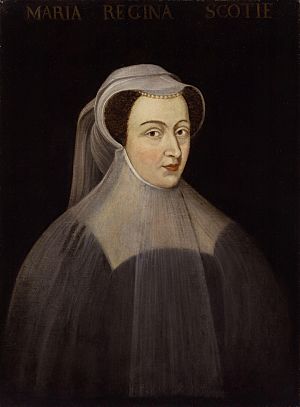Entry of Mary, Queen of Scots, into Edinburgh facts for kids
On 19 August 1561, Mary, Queen of Scots, who was 18 years old, came back to Scotland from France. Her husband, King Francis II of France, had passed away the winter before. To celebrate her return, the town of Edinburgh planned a special welcome event for her on 2 September.
Contents
Planning a Royal Welcome
The town of Edinburgh wanted to make Mary's return memorable. On 26 August, the town council met to plan a big dinner for the queen and her family. They also wanted to put on a grand "triumph" for her official entry into the town.
The leader of Edinburgh, Archibald Douglas of Kilspindie, discussed how to pay for everything. Some people, like the goldsmith Thomas Ewyn, had concerns about the cost. Luke Wilson, the town's treasurer, was put in charge of organizing the dinner and the special entry celebration. He also made sure the men carrying the queen's canopy and the town's guards had their costumes ready.
A carpenter named Patrick Schang built the special stages for the performances. These stages were set up at different points along the procession route, including the Butter Tron, Tolbooth, Cross, Salt Tron, and Netherbow. Walter Binning was the artist who painted these stages. The big dinner for the queen was held at Cardinal Beaton's house in the Cowgate area of Edinburgh.
Mary's Grand Procession
For the celebration, tailors made special black mourning cloaks and skirts for Mary and her 15 ladies. Mary wore a fancy black fabric called Florence serge. The other ladies wore a cheaper black fabric.
On the day of the event, Mary rode from Holyrood Palace to Edinburgh Castle, where she had dinner. After her meal, she went to the Castlehill, which is part of the High Street. There, she met an escort of 50 young men from Edinburgh. These men were dressed in special costumes, representing imagined African people. Some of their costumes were made of white taffeta. They wore rings in their mouths and gilded (gold-colored) chains around their necks and arms.
Mary rode under a beautiful "paill," which was a canopy made of purple velvet with gold fringes. Twelve townsmen, dressed in black velvet, held it up for her.
Pageants and Performances
As Mary moved through the town, she stopped at several places where special performances, called pageants, were put on for her:
- Butter Tron: At this spot, a boy dressed as an angel appeared from a globe. He gave Mary the keys to the town, a Bible, and a Psalter (a book of psalms).
- Tolbooth: On a double stage, four male actors dressed as women represented important virtues: Fortitude (courage), Justice, Temperance (self-control), and Prudence (wisdom).
- The Cross: Wine flowed from a fountain, and four young women performed a symbolic play.
- Salt Tron: Here, a pageant showing a religious story was performed.
- Netherbow: At the edge of Edinburgh, a dragon spoke to the queen and was then set on fire.
- Holyrood Palace: As Mary arrived back at the palace, a cart full of school children spoke about the Scottish Reformation and sang a psalm.
Finally, a beautiful cupboard filled with gold-plated dishes was given to the queen in her outer room at Holyrood Palace. This gift was from the town council and was presented by the "honest men" who had carried her canopy.
Words of Welcome
The verses spoken by the boy who appeared from the globe and gave Mary the books have been saved. An English diplomat named Thomas Randolph even sent a copy to William Cecil.
The verses were a warm welcome to Mary, calling her "our Souveraine" and "our natyve quene." They said that Edinburgh, her main city, offered her two important books. These books were meant to help her understand how to live a godly life, how to rule her people and her land, and how her kingdom would be strong. The verses explained that the Bible was God's law and word, truly translated, and that accepting it with respect was important.
The verses also mentioned that the Provost (the head of the town council) and all the people of Edinburgh urged her to accept the Bible. They also gave her the keys to the city's gates. This was a sign that they and everything they owned – their bodies and goods – would always be ready to serve her as their queen. They asked her to understand their short time and good intentions, and to accept their hearts and efforts, knowing that everything belonged to her.
According to John Knox, a famous Scottish reformer, Mary smiled at the parts of the verses that praised her. However, she gave the Bible to her attendant, Arthur Erskine of Blackgrange.
Other Royal Celebrations
The grand events put on for Mary's entry into Edinburgh were similar to other royal festivals held in Scotland. These included:
- The entry of Margaret Tudor in 1503.
- The entry of James VI into Edinburgh in 1579.
- The entry and coronation of Anne of Denmark in 1590.
Royal baptisms also featured special performances, plays, and formal processions, such as:
- The baptism of James VI in 1566.
- The masque (a type of play) at the baptism of Prince Henry in 1594.
Images for kids
-
The first event put on for Mary, Queen of Scots was a banquet in the former lodging of Cardinal Beaton at the corner of the Cowgate and Blackfriar's Wynd




